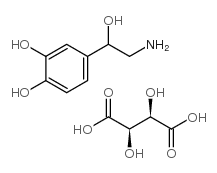Norepinephrine tartrate

Norepinephrine tartrate structure
|
Common Name | Norepinephrine tartrate | ||
|---|---|---|---|---|
| CAS Number | 3414-63-9 | Molecular Weight | 319.26500 | |
| Density | N/A | Boiling Point | 442.6ºC at 760 mmHg | |
| Molecular Formula | C12H17NO9 | Melting Point | N/A | |
| MSDS | Chinese USA | Flash Point | 221.5ºC | |
| Symbol |

GHS06 |
Signal Word | Danger | |
|
Sympathetic activity induced by naloxone-precipitated morphine withdrawal is blocked in genetically engineered mice lacking functional CRF1 receptor.
Toxicol. Appl. Pharmacol. 283(1) , 42-9, (2015) There is large body evidence indicating that stress can lead to cardiovascular disease. However, the exact brain areas and the mechanisms involved remain to be revealed. Here, we performed a series of experiments to characterize the role of CRF1 receptor (CRF... |
|
|
An assessment of norepinephrine mediated hypertrophy to apoptosis transition in cardiac cells: a signal for cell death.
Chem. Biol. Interact. 225 , 54-62, (2015) Heart is an organ which is under a constant work load that generates numerous stress responses. Heart failure is associated with increased plasma norepinephrine (NE) and hypertrophic cell death. Within the current study we try to understand the concentration ... |
|
|
Relationship between noradrenaline release in the locus coeruleus and antiallodynic efficacy of analgesics in rats with painful diabetic neuropathy.
Life Sci. 92(23) , 1138-44, (2013) In animal models of neuropathic pain, the noradrenergic descending pain inhibitory pathways from the locus coeruleus (LC) may be suppressed. However, no study has investigated the correlation between noradrenaline (NA) release in the LC and efficacy of analge... |
|
|
Prenatal exposure to permethrin influences vascular development of fetal brain and adult behavior in mice offspring.
Environ. Toxicol. 28(11) , 617-29, (2013) Pyrethroids are one of the most widely used classes of insecticides and show neurotoxic effects that induce oxidative stress in the neonatal rat brain. However, little is still known about effects of prenatal exposure to permethrin on vascular development in ... |
|
|
The water channel aquaporin-1 contributes to renin cell recruitment during chronic stimulation of renin production.
Am. J. Physiol. Renal Physiol. 307(11) , F1215-26, (2014) Both the processing and release of secretory granules involve water movement across granule membranes. It was hypothesized that the water channel aquaporin (AQP)1 directly contributes to the recruitment of renin-positive cells in the afferent arteriole. AQP1(... |
|
|
Postoperative polymyxin B hemoperfusion and mortality in patients with abdominal septic shock: a propensity-matched analysis.
Crit. Care Med. 42(5) , 1187-93, (2014) To examine the effect of postoperative polymyxin B hemoperfusion on mortality in patients with abdominal septic shock triggered by lower gastrointestinal tract perforation, identifying subpopulations of patients who may benefit from this treatment.Propensity-... |
|
|
Evidence against a systemic arterial defect in patients with inflammatory bowel disease.
J. Surg. Res. 191(2) , 318-22, (2014) Despite increasing interest in local microvascular alterations associated with inflammatory bowel disease (IBD), the potential contribution of a primary systemic vascular defect in the etiology of IBD is unknown. We compared reactivity of large diameter mesen... |
|
|
Postural tachycardia syndrome (POTS).
Circulation 127(23) , 2336-42, (2013)
|
|
|
Effects of pharmacologic dopamine β-hydroxylase inhibition on cocaine-induced reinstatement and dopamine neurochemistry in squirrel monkeys.
J. Pharmacol. Exp. Ther. 350(1) , 144-52, (2014) Disulfiram has shown promise as a pharmacotherapy for cocaine dependence in clinical settings, although it has many targets, and the behavioral and molecular mechanisms underlying its efficacy are unclear. One of many biochemical actions of disulfiram is inhi... |
|
|
Adipose tissue lipolysis and circulating lipids in acute and subacute critical illness: Effects of shock and treatment
J. Crit. Care 29(6) , 1130.e5-9, (2014) Purpose The purpose of this study is to assess lipid metabolism at the tissue level in critically ill subjects. |